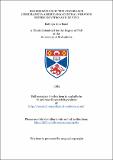Files in this item
Regeneration of the cockroach (periplaneta Americana) central nervous system in vitro and in vivo
Item metadata
| dc.contributor.advisor | Pitman, Robert M. | |
| dc.contributor.advisor | Lamb, J. F. | |
| dc.contributor.author | Rand, Kathryn Ann | |
| dc.coverage.spatial | 258 p. | en_US |
| dc.date.accessioned | 2018-07-02T10:13:31Z | |
| dc.date.available | 2018-07-02T10:13:31Z | |
| dc.date.issued | 1983 | |
| dc.identifier.uri | https://hdl.handle.net/10023/14782 | |
| dc.description.abstract | The central nervous system of the cockroach is able to recover following nerve lesions, by specific re-innervation of targets. Some aspects of such regeneration were studied in vitro and in vivo to discover how this is achieved. Neural explants from the cockroach central nervous system were maintained in culture for UP to six months. The effect of various parameters, such as temperature and growth medium composition upon the rate and extent of fibre outgrowth was studied. There was no apparent selectivity in the formation of connections between co-cultured neural or muscular explants, suggesting that the cues necessary for specific re-innervation in vivo may be absent in vitro. Under normal conditions, outgrowth usually began by about five days in culture. The delay before onset of fibre outgrowth, however, was reduced by prior section of nerves in situ two to three weeks before explantation of ganglia into culture. Outgrowth from these nerves which had received a 'conditioning lesion' was observed as soon as 12-24 hours after explantation into culture. Similarly, functional recovery occurred sooner in vivo after equivalent operations: normal function returned to animals more quickly after a second lesion to the same nerve, than after one lesion only. The morphology of an identifiesd motoneurone was studied by intracellular cobalt injection, to assess the effect of maintenance in culture, or of different nerve lesions performed in vivo. Nerve lesions caused changes in the branching pattern of this identified neurone. The extent of change appeared to be determined largely by the overall extent of damage to the nervous system. Direct damage to the cell was not a pre-requisite for changes to occur. In many cases, supernumerary branches entered territory which was normally foreign to the motoneurone. In some areas this growth appeared to be random, while in others sprouts gave the appearance of following paths of degenerating nerve fibres. It is concluded that at least some adult insect neurones are capable of extensive regenerative growth, and of undergoing a high degree of structural modification, both in vivo and in vitro, indicating that some plasticity is a feature of the adult insect nervous system. | en_US |
| dc.language.iso | en | en_US |
| dc.publisher | University of St Andrews | |
| dc.subject.lcc | QP363.5R2 | |
| dc.subject.lcsh | Developmental neurobiology | en |
| dc.title | Regeneration of the cockroach (periplaneta Americana) central nervous system in vitro and in vivo | en_US |
| dc.type | Thesis | en_US |
| dc.contributor.sponsor | Maitland Ramsay studentship fund | en_US |
| dc.type.qualificationlevel | Doctoral | en_US |
| dc.type.qualificationname | PhD Doctor of Philosophy | en_US |
| dc.publisher.institution | The University of St Andrews | en_US |
This item appears in the following Collection(s)
Items in the St Andrews Research Repository are protected by copyright, with all rights reserved, unless otherwise indicated.

